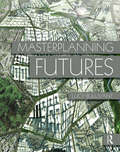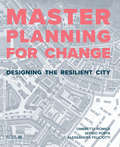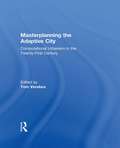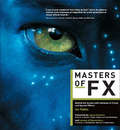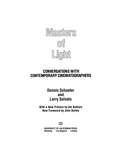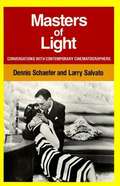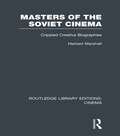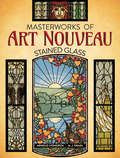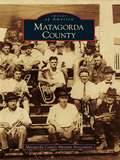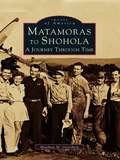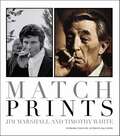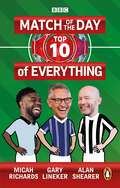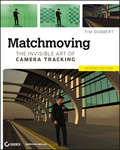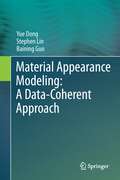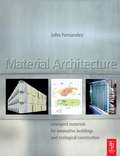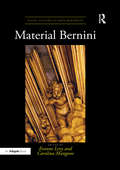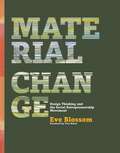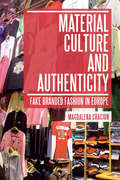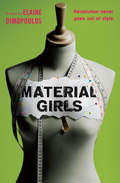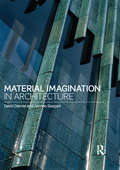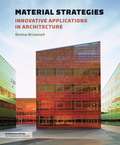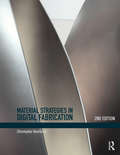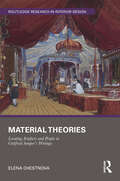- Table View
- List View
Masterplanning Futures
by Lucy BullivantWinner of the Urban Design Group's 2014 Book of the Year Award! In the past, spatial masterplans for cities have been fixed blueprints realized as physical form through conventional top down processes. These frequently disregarded existing social and cultural structures, while the old modernist planning model zoned space for home and work. At a time of urban growth, these models are now being replaced by more adaptable, mixed use plans dealing holistically with the physical, social and economic revival of districts, cities and regions. Through today’s public participative approaches and using technologically enabled tools, contemporary masterplanning instruments embody fresh principles, giving cities a greater resilience and capacity for social integration and change in the future. Lucy Bullivant analyses the ideals and processes of international masterplans, and their role in the evolution of many different types of urban contexts in both the developed and developing world. Among the book’s key themes are landscape-driven schemes, social equity through the reevaluation of spatial planning, and the evolution of strategies responding to a range of ecological issues and the demands of social growth. Drawing on first-hand accounts and illustrated throughout with colour photographs, plans and visualizations, the book includes twenty essays introduced by an extensive overview of the field and its objectives. These investigate plans including one-north Singapore, Masdar City in Abu Dhabi, Xochimilco in Mexico City and Waterfront Seattle, illuminating their distinct yet complementary integrated strategies. This is a key book for those interested in today’s multiscalar masterplanning and conceptually advanced methodologies and principles being applied to meet the challenges and opportunities of the urbanizing world. The author's research was enabled by grants from the Commission for Architecture and the Built Environment (CABE), the SfA (the Netherlands Architecture Fund), the Danish Embassy and support from the Alfred Herrhausen Society.
Masterplanning for Change: Designing the Resilient City
by Sergio Porta Ombretta Romice Alessandra FeliciottiCities are under increased pressure to be resilient and resistant to the effects of climate change and rapid urbanisation. However, this idea has still not been fully integrated in to practice. This book presents a practical approach to masterplanning the city and its areas (existing and new) as urban environments for the 21st century, addressing the design of cities as complex adaptive systems.
Masterplanning the Adaptive City: Computational Urbanism in the Twenty-First Century
by Tom VerebesComputational design has become widely accepted into mainstream architecture, but this is the first book to advocate applying it to create adaptable masterplans for rapid urban growth, urban heterogeneity, through computational urbanism. Practitioners and researchers here discuss ideas from the fields of architecture, urbanism, the natural sciences, computer science, economics, and mathematics to find solutions for managing urban change in Asia and developing countries throughout the world. Divided into four parts (historical and theoretical background, our current situation, methodologies, and prototypical practices), the book includes a series of essays, interviews, built case studies, and original research to accompany chapters written by editor Tom Verebes to give you the most comprehensive overview of this approach. Essays by Marina Lathouri, Jorge Fiori, Jonathan Solomon, Patrik Schumacher, Peter Trummer, and David Jason Gerber. Interviews with Dana Cuff, Xu Wei Guo, Matthew Prior, Tom Barker, Su Yunsheng, and Brett Steele. Built case studies by Zaha Hadid Architects, James Corner Field Operations, XWG Studio, MAD, OCEAN Consultancy Network, Plasma Studio, Groundlab, Peter Trummer, Serie Architects, dotA, and Rocker-Lange Architects.
Masters of FX: Behind the Scenes with Geniuses of Visual and Special Effects
by Ian FailesIt would be rare these days to find a film that did not in some way depend on the magic of visual effects, from the raging computer-generated dinosaurs in Steven Spielberg's Jurassic Park, to the fantastical worlds of Tim Burton's Alice in Wonderland, and the photoreal tiger and ocean in Ang Lee's Life of Pi. Through interviews with 16 of the leading effects pioneers from around the world (see list below), author Ian Failes explores the making of some of the most memorable film sequences ever produced, showcasing the shift from practical to digital magic with original behind-the-scenes imagery, shot breakdowns, and detailed explanations of some of the secrets behind the making of cinema's most extraordinary creations. Visual effects artists and films discussed include: Dennis Muren (Star Wars: Episodes IV–VI; Terminator 2: Judgment Day; Jurassic Park; A.I. Artificial Intelligence; War of the Worlds) Bill Westenhofer (Babe: Pig in the City; Cats & Dogs; The Lion, the Witch and the Wardrobe; The Golden Compass; Life of Pi) Joe Letteri (The Lord of the Rings trilogy; King Kong; Avatar; Planet of the Apes; The Hobbit trilogy) Rob Legato (Apollo 13; Titanic; The Aviator; Hugo) Paul Franklin (Pitch Black; Christopher Nolan’s The Dark Knight trilogy; Inception; Interstellar) Richard Edlund (Star Wars: Episodes IV–VI; Raiders of the Lost Ark; Ghostbusters; Multiplicity); Edson Williams (X-Men: The Last Stand; The Curious Case of Benjamin Button; The Social Network; Captain America films) Karen Goulekas (Godzilla; The Day After Tomorrow; 10,000 BC; Green Lantern); Chris Corbould (Golden Eye; Die Another Day; Christopher Nolan’s The Dark Knight trilogy; Inception); Ian Hunter (The X-Files; The Dark Knight; The Dark Knight Rises; Inception; Interstellar) John Rosengrant (Terminator films; Jurassic Park; Iron Man films; Real Steel)
Masters of Light
by Dennis Schaefer Larry Salvato John BaileyThrough conversations held with fifteen of the most accomplished contemporary cinematographers, the authors explore the working world of the person who controls the visual look and style of a film. This reissue includes a new foreword by cinematographer John Bailey and a new preface by the authors, which bring this classic guide to cinematography, in print for more than twenty-five years, into the twenty-first century.
Masters of Light: Conversations with Contemporary Cinematographers
by Dennis Schaefer Larry SalvatoThrough conversations held with fifteen of the most accomplished contemporary cinematographers, the authors explore the working world of the person who controls the visual look and style of a film.
Masters of the Soviet Cinema: Crippled Creative Biographies (Routledge Library Editions: Cinema)
by Herbert MarshallEisenstein, Pudovkin, Dovzhenko, Vertov: these Soviet film directors are acknowledged to be among the greatest in the history of cinematography. To Eisenstein we owe such films as Battleship Potemkin and October; to Pudovkin Mother and The End of St Petersburg; to Dovzhenko Earth and Zvenigora; and to Vertov The Man With a Movie Camera and The Three Songs of Lenin. Herbert Marshall knew each of them personally, both as artists and as friends, and shared their cinema world when he was a student at the GIK (The Moscow State Institute of Cinematography) in the heady years following the Revolution into the period of the first Five Year Plan. His material is culled from personal recollections, diaries, notes, unpublished and published biographies, letters, press cuttings, articles and books in various languages, but mainly from Soviet sources and the Soviet cinema world. Taking the subjects one by one, this indispensible book discusses their major films including an account of their creation and reception in the USSR and abroad. It shows the tragedy of these four Soviet artists who were lucky enough not to be arrested or deprived of their limited freedom, yet who nevertheless ended up with ‘crippled creative biographies’. The author then examines the changed viewpoint in the climate of 1983 when the book was originally published.
Masterworks of Art Nouveau Stained Glass
by M. J. Gradl Arnold LyongrunArt Nouveau was the dominant art style in both Europe and America at the turn of the 20th century. Its organic, curvilinear designs influenced painting, architecture, and sculpture, but it was in the decorative arts that Art Nouveau made its most lasting impression. One of its most delightful expressions can be seen in the delicately colored stained glass designs of the period, in which muted tones complement flowing representations of birds, animals, geometrics, foliage, and flowers. This volume combines two rare and important early 20th-century portfolios to present nearly 200 full-color stained glass designs.The first of these volumes, previously published as Arnold Lyongrün's Masterpieces ofArt Nouveau Stained Glass, is reproduced directly from an extremely rare original edition created by the German-born artist. More than 90 magnificent motifs include lovely floral and foliate designs, graceful female figures in flowing robes, pastoral landscapes, seascapes dominated by billowing sails, humorous depictions of animals, and more. The second collection featured in this single-volume compilation, previously published as M. J. Gradl's Authentic Art Nouveau Stained Glass Designs in Full Color, presents more than 100 full-color Art Nouveau stained glass designs from the hard-to-find early 20th-century portfolio Bunte Verglasungen. The book's authentic, original designs were the work of several fine contemporary artists, including Raoul Bacard, René Beauclair, George Montague Ellwood, Rudolf Geyling, Josef Goller, and others. As a sourcebook for inspiration or direct use, this handsome collection of authentic full-color, royalty-free designs will be a welcome addition to any designer's studio or craftsman's workshop.
Matagorda County
by Matagorda County Museum AssociationMatagorda County is centered in the Texas Coastal Bend at the crossroads of the Colorado River and the Gulf of Mexico. The name Matagorda, Spanish for "thick brush," was derived from the canebrakes that formerly lined the extensive shoreline. This vast coastal prairie is rich in history and tradition, with its roots dating back to 1685 when the explorer LaSalle sailed into Matagorda Bay. Later Stephen F. Austin used the seaports of Matagorda and Brazoria to build his new colony. The Gulf of Mexico, the rivers, the rich agricultural soil, the natural habitat full of wild game and birds, and the determined spirit of the people make the cities of Bay City, Palacios, Blessing, Sargent, and Matagorda an exquisite mix of history and tradition.
Matamoras to Shohola: A Journey Through Time
by Matthew M. OsterbergMatamoras to Shohola: A Journey Through Time tells the story of the Matamoras, Mill Rift, Westfall, Milford, Shohola, and Dingman Township people from 1860 to 1960. This exquisite collection of images features all aspects of life in theses areas, from the tourism industry to transportation to notable figures in history. Author and local historian Matthew M. Osterberg combines an impressive and unprecedented collection of photographs with a thoroughly researched text in this timeless tribute to the people and places of these Pennsylvania towns. Still a popular weekend and summer retreat for residents of New York and Philadelphia, Matamoras has attracted many tourists over the years. Included in this remarkable collection are images of the hotels and boarding houses of yesteryear. View the Hotel Fauchere, built in 1852 by Louis Fauchere, a chef at Delmonico's in New York and where Lobster Newburg was created. Also included are images of actress Lilliam Gish and philosopher Charles Peirce, the founder of Pragmatism. Discover the tranquility of tree-lined streets and splendid homes, and the farms that have since vanished in an age of shopping centers. Depicted in the collection is the crucial role that water continues to play inn both the commerce and recreation of these communities. Remy Loreaux, proprietor of the Silver Spring House Brewery, produced the first American bottled beer in Dingman Township.
Match Prints
by Timothy White Jim MarhsallMatch Prints is a visual and editorial dialogue between two important photographers and longtime friends. Over the course of their twenty-year friendship, Jim Marshall and Timothy White discovered that their work often shared striking similarities despite time differences of as much as three decades. Sometimes the similarity presented itself in the form of a common pose or expression, a common prop or situation. Sometimes the photographers' subject was the same, the images taken decades apart. Marshall and White have collaborated in selecting more than fifty stunning pairings for publication for the first time in Match Prints. An introduction by renowned music writer Anthony DeCurtis compares the work of the two photographers and provides firsthand behind-the-scenes anecdotes—an entertaining, informative read that sheds light on the photographers' approach to their work and captures the essence of their enduring friendship. Also included throughout the book are first-person anecdotes from the subjects themselves on the images and their creation.Whether poignant, dramatic, hilarious, or shocking, these are powerful visual pairings by two masters of photography.
Match of the Day: Our Ultimate Football Debates
by Gary Lineker Alan Shearer Micah RichardsFootball isn't life or death - it's much more serious than that...Which players will the fans never forget? Who are the Premier League's best buys? Who were the best link ups in history? In Match of the Day Top 10 of Everything, Gary Lineker, Alan Shearer and Micah Richards bring all of the charm, wit and punditry of their hit BBC Sounds podcast onto the page, arguing the toss over their favourite strikers, Premier League managers, shock transfers, cult heroes, hard men, FA Cup Finals, and much, much more. The question is...will you agree with their picks?
Matchmoving
by Tim DobbertGet your foot in the studio door by learning the art of matchmovingMatchmoving is a technique that allows computer graphics to be inserted into live-action footage with correct position, scale, orientation, and motion. Also known as motion tracking, it's what allows movie monsters to run down Main Street and robots to run through crowds--and look real. Now this unique book from a top expert from Industrial Light and Magic teaches you the art of matchmoving.With step-by-step tutorials and pages of examples, this book first explains the basics and then shows you professional techniques, from 3D calibration and tracking, to stereoscopy, and more.Explains concepts and teaches professional techniques for successful matchmoving Authored by a top matchmove specialist from Industrial Light and Magic, who walks you through step-by-step tutorials and impressive examples Covers matchmoving basics, 2D tracking, 3D calibration and tracking, automatic tracking, cameras, integrating matchmoves, and stereoscopyLearn how studio visual effects professionals make all the right matchmoves with Matchmoving: The Invisible Art of Camera Tracking 2nd Edition.
Material Appearance Modeling: A Data-Coherent Approach
by Baining Guo Yue Dong Stephen LinA principal aim of computer graphics is to generate images that look as real as photographs. Realistic computer graphics imagery has however proven to be quite challenging to produce, since the appearance of materials arises from complicated physical processes that are difficult to analytically model and simulate, and image-based modeling of real material samples is often impractical due to the high-dimensional space of appearance data that needs to be acquired. This book presents a general framework based on the inherent coherency in the appearance data of materials to make image-based appearance modeling more tractable. We observe that this coherence manifests itself as low-dimensional structure in the appearance data, and by identifying this structure we can take advantage of it to simplify the major processes in the appearance modeling pipeline. This framework consists of two key components, namely the coherence structure and the accompanying reconstruction method to fully recover the low-dimensional appearance data from sparse measurements. Our investigation of appearance coherency has led to three major forms of low-dimensional coherence structure and three types of coherency-based reconstruction upon which our framework is built. This coherence-based approach can be comprehensively applied to all the major elements of image-based appearance modeling, from data acquisition of real material samples to user-assisted modeling from a photograph, from synthesis of volumes to editing of material properties, and from efficient rendering algorithms to physical fabrication of objects. In this book we present several techniques built on this coherency framework to handle various appearance modeling tasks both for surface reflections and subsurface scattering, the two primary physical components that generate material appearance. We believe that coherency-based appearance modeling will make it easier and more feasible for practitioners to bring computer graphics imagery to life. This book is aimed towards readers with an interest in computer graphics. In particular, researchers, practitioners and students will benefit from this book by learning about the underlying coherence in appearance structure and how it can be utilized to improve appearance modeling. The specific techniques presented in our manuscript can be of value to anyone who wishes to elevate the realism of their computer graphics imagery. For understanding this book, an elementary background in computer graphics is assumed, such as from an introductory college course or from practical experience with computer graphics.
Material Architecture
by John FernandezComposed of a series of essays, this book deals with the broad issues affecting the nature of architectural materials and provides a focused review of the state of the art materials. It also provides designers with the tools they need to evaluate and select from the thousands of different materials that are available to them. The book is organized into three sections; ‘Time’ looks at how the materials used in architectural design have changed over the years showing how we have come to use the materials we do in contemporary design. ‘Materials’ covers all five material families; metals, polymers, ceramics, composites and natural materials giving in depth information on their properties, behavior, origins and uses in design. It also introduces a review of the cutting edge research for each family. ‘Systems’ outlines the technical design-orientated research that uncovers how new architectural assemblies can be designed and engineered. All of this practical advice is given along with many real case examples illustrating how this knowledge and information has been, and can be, used in architectural design.
Material Bernini (Visual Culture in Early Modernity)
by Evonne Levy Carolina MangoneBringing together established and emerging specialists in seventeenth-century Italian sculpture, Material Bernini is the first sustained examination of the conspicuous materiality of Bernini’s work in sculpture, architecture, and paint. The various essays demonstrate that material Bernini has always been tied (whether theologically, geologically, politically, or in terms of art theory) to his immaterial twin. Here immaterial Bernini and the historiography that sustains him is finally confronted by material Bernini. Central to the volume are Bernini’s works in clay, a fragmentary record of a large body of preparatory works by a sculptor who denied any direct relation between sketches of any kind and final works. Read together, the essays call into question why those works in which Bernini’s bodily relation to the material of his art is most evident, his clay studies, have been configured as a point of unmediated access to the artist’s mind, to his immaterial ideas. This insight reveals a set of values and assumptions that have profoundly shaped Bernini studies from their inception, and opens up new and compelling avenues of inquiry within a field that has long remained remarkably self-enclosed.
Material Change
by Yves Behar Eve BlossomMaterial Change shows that there is something going on in design-something powerful. Design can change the world. This new way of thinking is revolutionizing the business of design and the design of business.Material Change is the story of trained architect and entrepreneur Eve Blossom, who built her design business, Lulan Artisans, on a framework of ecological, economic, social, communal and cultural sustainability.Lulan Artisans is a for-profit social venture that designs, produces and markets contemporary textiles made by Blossom's collaborators-over 650 weavers, dyers, spinners and finishers in Cambodia, India, Laos, Thailand and Vietnam. Lulan's mission is to effect systemic social change: to give workers an ample wage and benefits; to bring stability to communities by creating jobs; to preserve artisanal skills; and to provide economic alternatives so that individuals can make better economic choices.In the book, we follow Eve's process of forming a grassroots, for-profit social venture. She openly shares her story and the thinking behind her vision, in the hope of inspiring others to act and to open-source the model for others to adapt, customize and share. Material Change also brings us the distinct voices of a range of other social entrepreneurs who are working around the world, including Muna AbuSulayman, Patrick Awuah, Shashin Chokshi, Tali Gottlieb, Joi Ito, Dr. Jordan Kassalow, Shaffi Mather, Tobias Rose-Stockwell, Juliana Rotich and Ricardo Terán.Social entrepreneurship is a movement, and it is growing every day. We don't know when the tipping point will be, but this new approach is here to stay. This is the new sustainable and holistic business model for the twenty-first century.Eve Blossom is the founder and CEO of Lulan Artisans. An architect by training, Eve lectures worldwide on sustainable integrated design and innovative business methodologies. She is a TED speaker and an Aspen Institute Liberty Fellow. This is her first authored book. This is the ebook edition of Material Change, originally published in print form in October, 2011.
Material Culture and Authenticity: Fake Branded Fashion in Europe (Materializing Culture)
by Magdalena CraciunThe study of material culture demonstrates that objects make people just as much as people make, exchange and consume objects. But what if these objects are, in the eyes of others, only fakes? What kind of material mirror are people looking into? Are their real selves really reflected in this mirror? This book provides an original and revealing study into engagements with objects that are not what they are claimed and presumed to be and, subsequently, are believed to betray their makers as well as users. Drawing upon an ethnography of fake branded garments in Turkey and Romania, Material Culture and Authenticity shows how people can make authentic positions for themselves in and through fake objects.The book will be of interest to students and scholars working in the fields of anthropology, material culture and cultural studies as well as to general readers interested in ethnographic alternatives to biographies of famous fakers and fakes.
Material Girls: A Novel
by Elaine DimopoulosIn Marla Klein and Ivy Wilde&’s world, teens are the gatekeepers of culture. A top fashion label employs sixteen-year-old Marla to dictate hot new clothing trends, while Ivy, a teen pop star, popularizes the garments that Marla approves. Both girls are pawns in a calculated but seductive system of corporate control, and both begin to question their world&’s aggressive levels of consumption. Will their new &“eco-chic&” trend subversively resist and overturn the industry that controls every part of their lives? Smart, provocative, and entertaining, this thrilling page-turner for teens questions the cult like mentality of fame and fashion. Are you in or are you out?
Material Imagination in Architecture
by David Dernie Jacopo GaspariMaterial Imagination in Architecture draws on history and the visual arts, and contemporary architecture to explore this popular theme in architectural practice and education. In the context of a discipline increasingly driven by digital production, this text explores architecture and making and the diverse influences on the material reality of architectural form: it argues that the crafts, fabrication and assemblage of its making remain vital elements of contemporary architectural language. This broad-ranging text bridges the gap between a technical or otherwise fragmentary knowledge of materials of the specialist, and the tacit or instinctive understanding of materials that the artist, sculptor or architect may have. It identifies key material themes pertinent to contemporary architectural debate and develops a discourse about future practice that is framed by environmental imperatives and grounded in a historical understanding of the meaning and use of materials. Material iconology in architecture is a well-established tradition and this book draws on that background to investigate the possibilities, and limits, of using materials in contemporary design to communicate the themes and contexts of an architectural project, a material’s relationship to context, and to the history of practices that belong to the traditions of making buildings. Each theme is explored in case studies from twelve countries around the world, including the UK, USA, Spain, Italy, Germany, Australia and China.
Material Matters: Architecture and Material Practice
by Katie Lloyd ThomasBringing together texts and work by theorists and practitioners who are making material central to their work, this book reflects the diverse areas of inquiry which are expanding current material discourse. Focusing on the cultural, political, economic, technological and intellectual forces which shape material practices in architecture, the contributors draw on disciplines ranging from philosophy, history and pedagogy to art practice and digital and low-tech fabrication. By paying critical attention to material, a wide range of issues emerge which are otherwise excluded from architectural discourse, issues that shape and determine the buildings we make, the processes we use and the ways we understand them. Beautifully illustrated and designed, this book is a unique collection which will be of great interest to architectural practitioners and theorists who want to consider the wider implications of material practice, and to students who are developing their own approach to making buildings.
Material Noise: Reading Theory as Artist's Book
by Anne M. RoystonAn argument that theoretical works can signify through their materiality—their “noise,” or such nonsemantic elements as typography—as well as their semantic content. In Material Noise, Anne Royston argues that theoretical works signify through their materiality—such nonsemantic elements as typography or color—as well as their semantic content. Examining works by Jacques Derrida, Avital Ronell, Georges Bataille, and other well-known theorists, Royston considers their materiality and design—which she terms “noise”—as integral to their meaning. In other words, she reads these theoretical works as complex assemblages, just as she would read an artist's book in all its idiosyncratic tangibility. Royston explores the formlessness and heterogeneity of the Encyclopedia Da Costa, which published works by Bataille, André Breton, and others; the use of layout and white space in Derrida's Glas; the typographic illegibility—“static and interference”—in Ronell's The Telephone Book; and the enticing surfaces of Mark C. Taylor's Hiding, its digital counterpart The Réal: Las Vegas, NV, and Shelley Jackson's Skin. Royston then extends her analysis to other genres, examining two recent artists' books that express explicit theoretical concerns: Johanna Drucker's Stochastic Poetics and Susan Howe's Tom Tit Tot.Throughout, Royston develops the concept of artistic arguments, which employ signification that exceeds the semantics of a printed text and are not reducible to a series of linear logical propositions. Artistic arguments foreground their materiality and reflect on the media that create them. Moreover, Royston argues, each artistic argument anticipates some aspect of digital thinking, speaking directly to such contemporary concerns as hypertext, communication theory, networks, and digital distribution.
Material Strategies
by Blaine BrownellIn the successful Transmaterial series, author Blaine Brownell presents collections of materials that have the potential to transform the physical environment. With Materials Strategies, Princeton Architectural Press s next book in its Architecture Brief series, Brownell takes his research to the next stage by addressing how materials be applied to affect such a transformation, ultimately achieving design innovation. [Architecture has been shaped by the continual transformation of material technologies and application methods throughout history. Surprisingly, these approaches are rarely taught in academia or practice the former typically focuses on building-technology sequence, where students are given information about basic material properties and conventional methodologies. Architectural practice is worse: in the majority of offices, there is no established discipline or method for material innovation despite the widespread belief in its importance. ] [katharine, this whole paragraph could be cut if this is too much, which I think it is. ] Material Strategies is a primer on materials that goes beyond a mere description of materials. It provides insights regarding emerging technologies as well as their creative implementation, and presents a series of recent case studies that demonstrate successful realization of material-based innovation. The book is structured by a concise set of chapters based on fundamental material categories mineral, concrete, wood, metal, glass, and plastic. The introduction of each chapter describes the basic history of the material and its importance to architecture, a summary of previous building innovations and their technological as well as cultural effects, current environmental challenges and their future ramifications, recent disruptive technologies and their preliminary manifestations, as well as a series of disruptive applications exemplified by recent pioneering buildings. Architectural case studies are described with a focus on the significance of their particular contributions, and are documented in detailed illustrations. The primary attention of the book is on contemporary projects because of the ways in which these buildings deliver creative contributions related to present-day circumstances. Unlike many how-to manuals, the emphasis here is on unconventional and emerging practices. Moreover, unlike many surveys of new materials, this manual seeks to explain which new material technologies are most significant and why, how these technologies are being influenced by recent environmental concerns, the theoretical implications and conceptual debates one must consider, as well as the ways in which new material strategies are utilized to advance the architectural canon.
Material Strategies in Digital Fabrication
by Christopher BeorkremIn this second edition of Material Strategies in Digital Fabrication are new case studies, improved wayfinding, the inclusion of composites and plastics, and references to similar strategies between different projects. In 400 step-by-step diagrams dissecting 39 case studies in 10 countries on 3 continents, the book shows you how material performance drives the digital fabrication process and determines technique. The book identifies the important characteristics of each material, including connection types, relative costs, deformation, color, texture, finish, dimensional properties, durability, and weathering and waterproofing to link design outcomes to form. The book is divided into five main chapters by material; wood, metal, concrete/masonry, composites/plastics, and recycled/pre-cycled, to help you reference construction techniques for the fabrication machines you have on-hand. Includes projects by SHoP Architects, Gramazio & Kohler, Schindlersalmeron, The Institute for Computational Design (Achim Menges, Patkau Architects,Sebastien Wierinck, Blue Dot Furniture, Marble Fairbanks, Studio Gang Architects, Macdowell.Tomova, Thomas Heatherwick Studio, Heather Roberge, MX3D, Matsys, Asbjorn Sondergaard, Block Research Group (Phillipe Block), Ball Nogues Studio, Matter Design, WORK Architecture Company, and SoftLab.
Material Theories: Locating Artefacts and People in Gottfried Semper's Writings (Routledge Research in Interior Design)
by Elena ChestnovaMaterial Theories takes a radically new approach to well-established thinking on nineteenth-century architecture and design by investigating Gottfried Semper’s classic ideas about dressing, metamorphosis of material, and cultural development, culminating in his two-volume publication Style. This book demonstrates how Semper’s theories crystallised among his encounters with material things of the late 1840s and early 1850s. It examines several discursive frameworks and phenomena which shaped the attitude to artefacts in Europe in the mid-nineteenth century, and which were specifically pertinent to Semper’s evolution: archaeology and antiquarianism, the domestic interior, print media, collections, and the embodied relationship between the designer and their work. For the first time, this book examines the construction of a design theory not only as an intellectual endeavour but also as a process of confrontation with material things. It employs recent approaches to material culture, in particular Thing Theory, in order to show that Semper’s artefact references constituted his ideas, rather than simply giving impetus to them. It will be an important investigation for academics and researchers interested in interior design history, as well as scholars of material culture and history of design theory.
